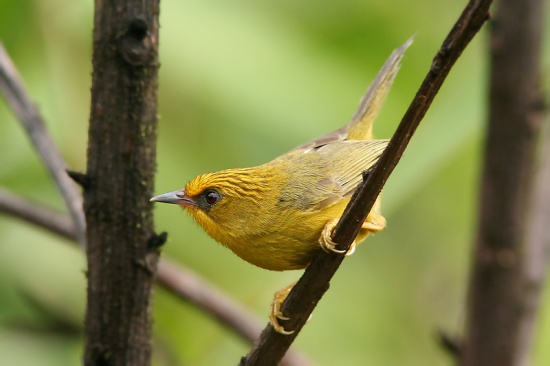Alternative name: Golden-headed Babbler
- Cyanoderma chrysaea
Stachyris chrysaea; Stachyridopsis chrysaeum
Identification
10 - 12cm. A distinctive, small babbler:
- Bright yellow crown and underparts
- Greenish-olive upperparts and flanks
- Black lores (some subspecies with dark to blackish ear-coverts)
- Black streaks on crown
- Dark crimson eye
Sexes similar. Juveniles are pale rufous overall and have no streaks on crown.
Distribution
Found from central Nepal east along the Himalayas to Bhutan, northeast India, adjacent Tibet and China (Yunnan to Guangxi) to Burma, Thailand, Laos, Vietnam, peninsular Malaysia and Sumatra (Indonesia).
Common in part of its range.
Taxonomy
Formerly placed in the genus Stachyris or in Stachyridopsis.
Subspecies
There are 6 subspecies[1]:
- C. c. chrysaeum:
- C. c. binghami:
- South-eastern Assam to south-western Myanmar (Chin Hills and Arakan Yoma Mts.)
- C. c. auratum:
- C. c. assimile:
- C. c. chrysops:
- Hills of Malay Peninsula
- C. c. frigidum:
- Highlands of western Sumatra
Habitat
Broadleaf evergreen forest, bamboo stand and dense bushes. Also found in deserted cultivation, clearings and secondary forest. Found at 300 - 2600m in the Indian Subcontinet, 450 - 2600m in southeast Asia and 680 - 3000m in Sumatra.
Behaviour
Outside breeding season found in groups with other species (like Grey-throated Babbler). Forages in lower to middle storeys.
Diet
Feeds on insects, takes sometimes also berries.
Breeding
Breeding season from January to July. The nest is a dome or ball with an entrance near the top. It's made of dry bamboo leaves and pine needles and placed on ground, in a bamboo clump or close to the ground in a bush. Lays 3 - 4 eggs.
Movements
Resident species with some seasonal wandering.
References
- Clements, J. F., T. S. Schulenberg, M. J. Iliff, D. Roberson, T. A. Fredericks, B. L. Sullivan, and C. L. Wood. 2015. The eBird/Clements checklist of birds of the world: v2015, with updates to August 2015. Downloaded from http://www.birds.cornell.edu/clementschecklist/download/
- Del Hoyo, J, A Elliott, and D Christie, eds. 2007. Handbook of the Birds of the World. Volume 12: Picathartes to Tits and Chickadees. Barcelona: Lynx Edicions. ISBN 978-8496553422
- Rasmussen, PC and JC Anderton. 2005. Birds of South Asia: The Ripley Guide. Barcelona: Lynx Edicions. ISBN 978-8487334672
Recommended Citation
- BirdForum Opus contributors. (2024) Golden Babbler. In: BirdForum, the forum for wild birds and birding. Retrieved 27 April 2024 from https://www.birdforum.net/opus/Golden_Babbler





